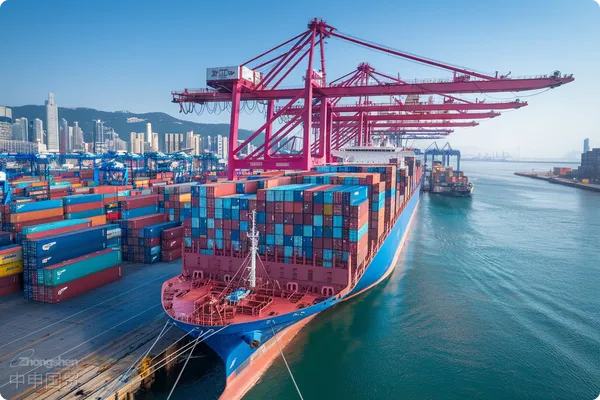- Shanghai Zhongshen International Trade Co., Ltd. - Two decades of trade agency expertise.
- Service Hotline: 139 1787 2118

The latest issue of the Shanghai Containerized Freight Index (SCFI) released by the Shanghai Shipping Exchange today shows that after three consecutive weeks of increase, the index has reversed for the first time, falling 9.68 points from last week to 2251.9 points, a decrease of 3.42%. This change has attracted widespread attention in the industry, and analysts have interpreted the reasons behind it and its potential impact on the future market.
Among the four major ocean - going routes, the Mediterranean route is the only one that shows a slight recovery, with a freight rate increase of 0.82%. In contrast, the Europe, East Coast of the United States, and West Coast of the United States routes all show a downward trend, with the West Coast of the United States route having the largest decline, reaching 11.59%. The Southeast Asia route continues to maintain strong growth, demonstrating the different performances of different routes in the current market environment.
According to industry insiders, starting from Monday this week, MSC Shipping Company will start to reduce freight rates. Specifically, the quoted price for the West Coast of the United States route will drop to $3150, the East Coast of the United States route will drop to $4850, and the Europe route will remain between $4200 - $4400. The West Coast of the United States route has seen a significant decline in the past week. The reason is that MSC reduced sailings during the National Day Golden Week, resulting in a decrease in supply. Subsequently, due to a three - day strike on the East Coast of the United States route, some goods were diverted to the West Coast of the United States route, supporting the increase in the freight rate of the West Coast of the United States route. However, after entering November, the supply of sailings returned to normal, and the volume of goods decreased, forcing West Coast of the United States shipping companies to adjust their freight rates. It is expected that other shipping companies will follow MSCs price adjustment measures within this week, further pushing down freight rates.
In addition, the peak shipping season of the Double Eleven e - commerce season has ended, and the market is currently facing the traditional off - season. Industry analysts pointed out that the next market trend will depend on whether a new wave of cargo - pulling boom will occur from mid - December to the Chinese New Year. Factors affecting this trend include the progress of the negotiations between East Coast of the United States dockworkers on the issue of terminal equipment automation, the development of tariff policies, and the early - break arrangements of factories during the Chinese Lunar New Year. These factors may have a significant impact on the freight market and determine the freight rate trends in the next few months.
In terms of specific freight rates, the changes in major shipping routes last week were as follows:
The freight rate from the Far East to Europe was $2512/TEU, a decrease of $29, a decline of 1.14%; the freight rate from the Far East to the Mediterranean was $3080/TEU, an increase of $25, an increase of 0.82%; the freight rate from the Far East to the West Coast of the United States was $4181/FEU, a decrease of $548, a significant decline of 11.59%; the freight rate from the Far East to the East Coast of the United States was $5062/FEU, a decrease of $219, a decline of 4.15%. The freight rate per container on the Persian Gulf route was $1421, a weekly decrease of $59, a decline of 3.99%; the freight rate per container on the South America route (Santos) was $5515, a weekly decrease of $416, a decline of 7.01%.
In terms of short - sea routes, the freight rates from the Far East to Kansai and Kanto in Japan were $304 and $305 respectively, unchanged from the previous period; the freight rate from the Far East to Southeast Asia was $670/TEU, an increase of $69, an increase of 11.48%; the freight rate from the Far East to South Korea was $138/TEU, a decrease of $9, a decline of 6.12%.
Market analysts generally believe that the current freight rate adjustment reflects the dynamic changes in the market supply - demand relationship. The reduction of sailings during the National Day Golden Week and the strike on the East Coast of the United States route once pushed up the freight rate of the West Coast of the United States route. However, as these short - term factors fade away, the freight rate has to be adjusted back. At the same time, the end of the Double Eleven e - commerce season also means a decline in market demand, further pushing down the freight rate.
Regarding the upcoming cargo - pulling boom, analysts suggest that enterprises and cargo owners closely monitor the progress of dockworker negotiations and the latest developments in tariff policies. These factors will not only affect changes in freight demand but may also affect the efficiency and cost structure of the entire supply chain by influencing freight costs and time. In addition, the factory break arrangements during the Chinese Lunar New Year also need to be taken into consideration, as this will directly affect the production and transportation schedules of goods.
Sam Stovall, the chief investment strategist of the US-based Center for Financial Research and Analysis, said, We may see stronger - than - expected activities in the US. The activities in December and currently in November are relatively robust. It may gradually slow down by the beginning of 2025. However, the active foreign trade activities (by the end of the year) may give the Federal Reserve a reason to pause (interest - rate cuts) or at least slow down the pace of rate cuts. Stovall pointed out that the current increase in foreign trade activities may have a certain impact on the Federal Reserves monetary policy, especially when it needs to find a balance between inflation and economic growth targets.import and exportHowever, the market also needs to be vigilant against potential risks and uncertainties. The high - tariff policy that may be implemented after Trumps election will not only affect companies procurement and pricing strategies but may also trigger tensions in international trade relations. Especially for the export business on the Europe, East Coast of the US and West Coast of the US routes, it may face greater fluctuations and uncertainties. When formulating future logistics and supply - chain strategies, companies need to fully consider the impact of these policy changes to ensure their competitiveness and flexibility in the rapidly changing market environment.foreign tradeOverall, the decline of the Shanghai Export Container Freight Index marks an important turning point in the market supply - demand relationship. While continuously observing market dynamics and policy changes, companies and investors need to adjust their strategies in a timely manner to cope with possible market fluctuations and the impact of economic policies. In the next few months, as the market enters the traditional off - season and there may be a potential cargo - pulling boom, the freight rate trend will remain highly sensitive and is worthy of continuous attention from both inside and outside the industry.
Trumps Victory Triggers Stockpiling Boom among US Companies: Whats the Impact of Tariff Policy?
Chinas Antimony Export Ban: A 97% Plunge, Global Market in Turmoil
Related Recommendations
? 2025. All Rights Reserved. 滬ICP備2023007705號-2  PSB Record: Shanghai No.31011502009912
PSB Record: Shanghai No.31011502009912









